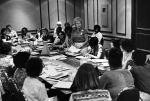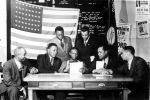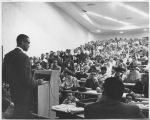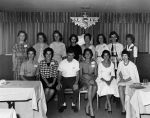Blogs
Notable Women of SEIU
Women have been a part of SEIU since its inception, when Elizabeth A. Grady was elected Trustee at the founding convention in 1921. Grady often reminded her fellow executive board members, all of whom were men, “You men must know that you cannot get very far or make any real progress if you have women workers who compete with you, unorganized and working for less wages” (Union Sisters, p. 16). Indeed, the American Federation of Labor (AFL) was keenly aware of the importance of organizing women, demonstrated by correspondence found in the SEIU Historical Records. Amidst the correspondence are documents sent by AFL’s then president Sam Gompers, such as reports detailing labor’s organization of women in Europe during the 1920s, as well as questionnaires to AFL Internationals, generating data on women in industry. However, given SEIU’s initial gender integration, in part due to SEIU’s organization of flat (apartment) janitors whose wives were expected to share in the work, SEIU already recognized the importance of women in the labor movement. Indeed, while not always in the most visible of positions, women, both rank-and-file members, and those within SEIU’s leadership, have made great contributions to SEIU and the greater labor movement over the years. In honor of Women’s History Month, we take a look at some of SEIU’s more prominent female leaders. read more »
African Americans and the UAW
- African American labor union members
- African Americans
- African Americans--Michigan--Detroit--History--20th century
- African labor leaders
- Anti-apartheid movements
- Automobile industry workers
- Bieber, Owen
- Civil rights--America
- Coalition of Black Trade Unionists (U.S.)
- Crockett, George W.
- Desegregation
- Desegregation
- Detroit (Mich.)
- Detroit--politics and government
- Detroit--race relations
- Dodge Revolutionary Union Movement
- Ford Motor Company
- Ford Rouge Plant
- Fraser, Douglas A. (Douglas Andrew), 1916-2008
- Integration
- Labor
- Lucy, William
- Mandela, Nelson, 1918-2013
- Michigan--History
- Race relations
- Reuther, Walter, 1907-1970
- Sheffield, Horace
- UAW
- UAW
- UAW Ford Local 600
- Walter P. Reuther Library
- Woodcock, Leonard
- Young, Coleman A.
The Reuther Library celebrates African American History Month with a brief review of the important role that African Americans have played in the formation and growth of the United Automobile Workers of America (UAW), one of the most powerful unions in American history, and the influence of black UAW members within the polity of Detroit. read more »
Subject Focus: Black Revolutionaries
- African Americans
- African Americans--Michigan--Detroit--History--20th century
- African Americans--Michigan--Detroit--History--Pictorial works
- African Americans--Michigan--Detroit--Social conditions--20th century
- Black militant organizations
- Black nationalism--United States
- Black Panther Party
- Black power--Michigan--Detroit
- Black Workers Congress
- Detroit (Mich.) Police Dept.
- Detroit--economic conditions
- Detroit--politics and government
- Detroit--race relations
- Detroit--social conditions
- Dodge Revolutionary Union Movement
- Radicalism
- Republic of New Africa (Organization)
- Student Nonviolent Coordinating Committee (U.S.)
- X, Malcolm, 1925-1965
The Reuther Library celebrates African American History Month with a brief look at resources in our collections that deal with the topic of Black revolutionaries. We define Black revolutionaries as persons or groups whose goal was to create a positive change in the lives of African Americans through radical action. The means to this end varied from person to person, organization to organization - the action could be carried out with words or through armed conflict, the desired results could be equality for all or separation of races all together. The following resources chronicle the struggle for identity and equality and highlight the rich legacy of social and political activism and reform within the various revolutionary movements. read more »
Flight Attendants and the Air Line Pilots Association
It was 1973, and the Air Line Pilots Association was rife with tension. Things hadn’t been working out for a while between the Steward and Stewardess and Pilot Divisions of ALPA. It was clear to both that “the Problem” (as the relationship between the Pilot and S&S Division was being referred to) needed to be fixed. But a solution, one which would work for both divisions, ensuring pilot control over ALPA and stewardess autonomy, proved elusive. While “the Problem” was first brought to the fore in 1970, it took one convention, four study groups, and countless meetings, proposals and counter proposals, for the two divisions to work out a solution and bring the Association of Flight Attendants into being. read more »




